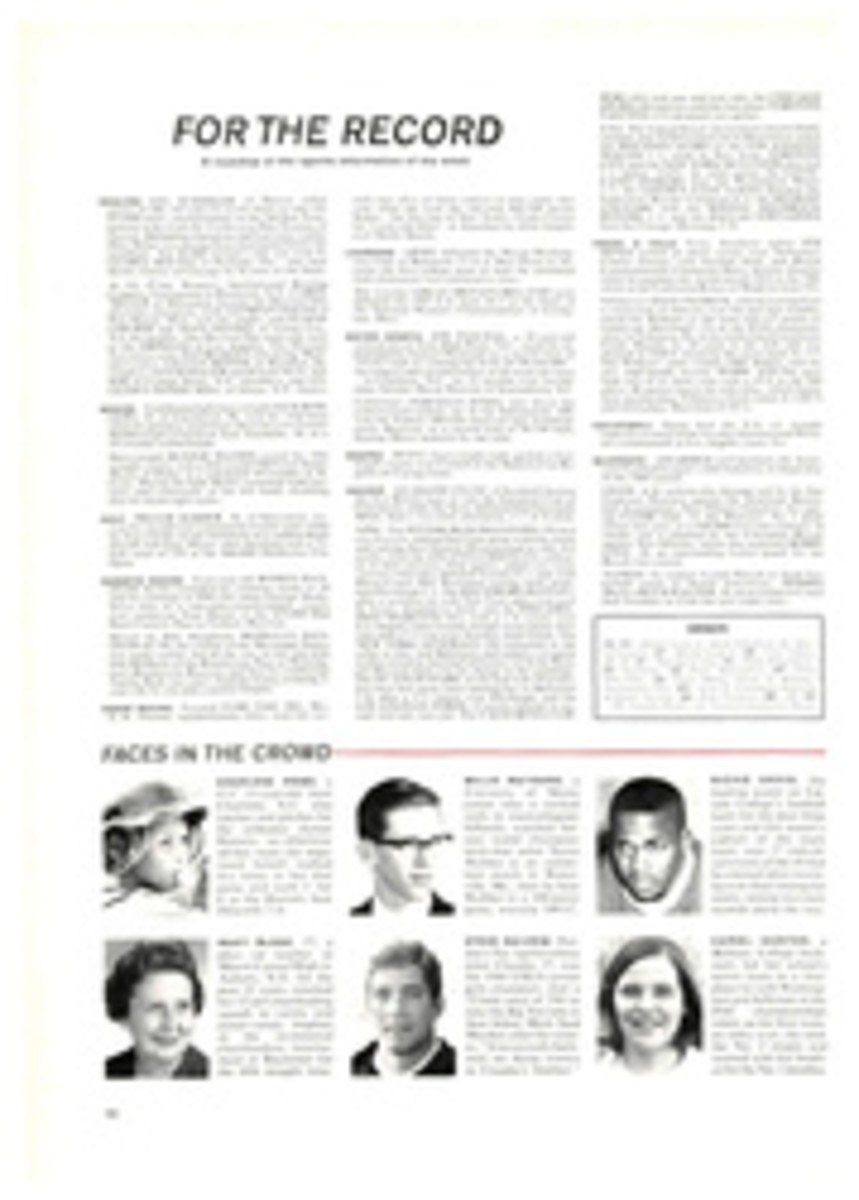
PLAYING IT THE JAPANESE WAY
Do you see? Do you see? He's tired now. I've worn him out." Maybe. But Ann Heck looked like the tired one. She stood with her back to the wall of a musty gymnasium in suburban Los Angeles last week. There were pads on her knees and elbows, her face was flushed red and her blonde hair tousled. Twenty feet away stood her coach, Harlan Cohen, bouncing volleyballs off her head, arms and shoulders. Ann was supposed to be deflecting the ball back to Cohen's hands, but after three minutes of steady battering she went off the floor, laughing, to restore some of the natural white to her pink, stinging forearms.
Over on the bench Jane Ward the captain of the United States Women's Volleyball Team, massaged a strained muscle in her left thigh as Alice Englert, the team's manager, trainer and travel agent, rummaged through a kit that did not contain any Pacquin hand cream or Revlon Blush-On. At last she found the Cramer's Atomic Balm and smeared it on Jane's leg, causing the leg to turn a bright orange, then red. "That'll put heat in the muscle," Alice said. "You'll play tomorrow."
If this seemed like odd behavior for pretty young misses, most of them from southern California, it was. They were getting ready to meet the Yashica Company club, national volleyball champion of Japan, in a two-match exhibition beginning the next night but, unlike any American girls' team before them, they had adopted the Japanese method of play—which, if you haven't heard, is less like play than it is like suicide. What's more the Americans expected to win a game or two, and that was the same as saying Floyd Patterson would one day take a round from Sonny Liston.
It would be pleasant to report that the dedicated Americans succeeded where many others before them failed. But they did not. They lost 15-8, 15-5, 15-4; 15-9, 15-4, 15-4. Still, the fact that they scored nine points in one of the games is cause enough for celebration. (At the last Olympics the Japanese girls beat the U.S. girls 15-1, 15-5, 15-2.) His girls' moral triumph had an almost dizzying effect on Cohen. "I believe," he said, "that a month from now we could beat them with ease."
For pure enthusiasm, there is almost nobody like Harlan Cohen. He is 32 years old, a bachelor and a substitute teacher in Los Angeles who refuses to teach full time because that would interfere with volleyball. The thought that the Americans might one day beat the Japanese struck him at Tokyo in 1964, even as the team driven by that fanatical coach, Hirobumi Daimatsu (SI, March 16, 1964), was destroying the Olympic competition.
Cohen marveled at the precision and determination of the Japanese women, who often had been forced to practice past midnight by Daimatsu after they had worked a full eight-hour day in a factory. He sent an interpreter to the library to translate key chapters from Daimatsu's book, Follow Me!, which was filled with such things as "Make the impossible possible.... When I considered their play insufficient I made them try over and over again however late it might be.... The severity of my training often made bystanders shut their eyes.... It was not only once that we practiced till the eastern sky became bright...."
Cohen returned to the U.S. convinced that the Japanese philosophy and drills, tailored to American culture, were all that our bigger, healthier and more gifted athletes needed to compete on an international level in volleyball. When the U.S. Olympic Committee appointed him coach of the women's team for the Pan American Games, he got his chance to institute an intensive volleyball program. Fortunately for him, he had a reads-made audience for his ideas in the American girls, who were just as impressed with the Japanese. "That made things a lot easier," Cohen said.
Cohen fired off letters to the girls long before they were to report for practice in Los Angeles last October for the World Games, which were held at Tokyo in January. The letters prescribed a hectic regimen of running and leaping and toe-twisting, contained homilies about the rigors of conditioning and usually ended with "good luck."
In camp Cohen sent the girls through drills that isolated the basic skills of volleyball—setting, blocking, spiking and serving—three or four hours a day, four or five days a week. He taught them the Japanese roll—how to fall without injury—and, as he says, "how to sweat." The girls thrived on the program and by December they had become so proficient that the only competition to be found for them was with men's teams.
The girls did not win the championship at the World Games, but they did win their confidence there. They beat a Japanese high school team seven times in a row, did well against two powerful club teams (which comprise the backbone of Japanese volleyball) and in the championships themselves they won the silver medal, behind Japan, to whom they lost 15-12, 15-0 and 15-8. "The Japanese," said Cohen, "had boasted that no team in the tournament would score five points on them. Our girls did it twice and forced them into errors I'd never seen a Japanese team make before."
Cohen enjoys working with women because he finds them more receptive to new ideas and techniques than the men. "Men," he says, "are still skeptical of the Japanese roll—the best way that has been found to save a spiked ball. Men would rather save the ball the American way, and stay off the floor." The women, says Cohen, go after everything; hardly a ball hits the floor without one of the girls at least touching it. "Maybe they don't save it," he says, "but they touch it. Next they'll be saving it."
Cohen tosses around phrases like "pain tolerance" in practice and, despite the improvement his approach has brought to U.S. volleyball, there has been opposition to the way he has driven the girls. Little of the criticism, however, has come from the girls themselves. On the contrary, they actually appear to enjoy diving onto the floor and dashing off after loose balls. Many of them are teachers and students with logical excuses to miss practice, but attendance is high at all the workouts, regardless of where they are held. Shar Buhlig, who is 34 and married, travels as much as three hours round trip. Elie Barbour, who is still trying to make the team, leaves two children at home with an understanding husband.
Linda Murphy, 6'3", could not run a city block before Cohen came along; now she runs a mile. She was easily the outstanding player in the world tournament, and after it was over the Japanese coach told Cohen that Linda just might become the best woman volleyball player in the world. Jane Ward has been playing the game for 15 years, but Cohen streamlined her style. Sharon Peterson, a pretty, 24-year-old blonde, has the instinct to sense what is going to happen next, much like a linebacker in football, and she has developed into the team's finest defender. "Ah, Sharon!" gushes Cohen. "And she is still so young, too."
The whole team is young. The 18-girl squad averages only 23 years and many of its best players are also the youngest. "And we're getting more and more good ones all the time," says Cohen. "But the thing that makes me happiest is that now our girls are diving for balls they don't have a chance of reaching. When I see them do that, I know we're on the right track."
TWO PHOTOS
Displaying their new-style hustle, Ninja Jorgensen drives a set by Jane Ward past two Japanese defenders (above) and Sharon Peterson makes a gallant attempt to save a spiked ball.

